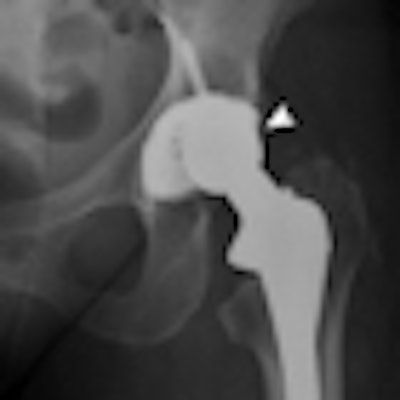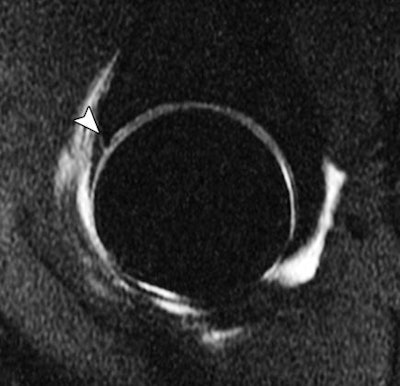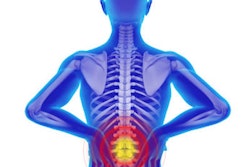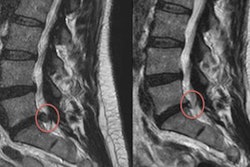
Yoga, that poetic and wildly popular integration of human body, breath, and mind that has swept the U.S. in recent years, does cause musculoskeletal problems, though rarely, according to a new study published in the August American Journal of Roentgenology that used imaging to assess yoga injuries.
Researchers from the University of British Columbia and Vancouver General Hospital scoured patient records over nine years and found yoga-related injuries in 20 of 38 patients. Tendinous lesions, including tears of the supraspinatus, Achilles, and peroneus brevis tendons, were the most common, followed by fibrocartilaginous tears involving the medial meniscus, acetabular labrum, glenoid labrum, and lumbar disk with extrusion, they wrote.
As for the complaints driving imaging exams, headache was by far the most common. On an anatomical basis, tendons, myotendinous junctions, and fibrocartilages are the structures most vulnerable to injury, wrote lead author Dr. Thomas Le Corroller and colleagues (AJR, August 2012, Vol. 199:2, pp. 413-418).
 |
| Sagittal T1-weighted MR arthrography image with fat saturation shows tear of anterior acetabular labrum (arrowhead) in 36-year-old woman. All images republished with permission of the American Roentgen Ray Society from AJR, August 2012, Vol. 199:2, pp. 413-418. |
"Yoga postures can be fairly demanding of flexibility and require strength of the stabilizing muscles to be performed safely and provide benefits," the authors wrote. "Particularly in large classes without adequate instruction, new yoga practitioners may attempt to perform postures that their bodies are not ready to accommodate. Even if a movement or posture does not elicit immediate injury, if performed incorrectly, it can strain structures over time at the weakest point, which eventually may progress to a frank injury."
The investigators conducted a retrospective search for the term "yoga" in the database of a radiology department at a large tertiary care center, covering nearly 2.2 million consecutive imaging exams from 2002 to 2011. Out-of-context references were excluded, and demographic data including age and sex of the patients, history, and imaging modality were recorded for the study.
The term yoga was found in 56 radiologic reports over the nine-year period. Eighteen reports were excluded, representing either duplicate cases or use of the word yoga out of context. An experienced staff radiologist along with three radiology fellows looked at the studies, evaluating them in consensus for yoga-related injuries, focusing on bone and soft-tissue injuries including fractures and dislocations, as well as muscular, tendinous, ligamentous, and fibrocartilaginous tears.
The reviewers found reports with acute symptoms related to yoga for 38 patients (10 men, 28 women; mean age, 46 years; range, 19-67 years). After excluding negative imaging findings, there were 23 injuries attributable to yoga in 20 patients. Imaging exams used in the patient population included eight MRI scans, seven ultrasound scans, three CT exams, and two x-ray studies.
The anatomic regions examined included the knee in five cases; the shoulder, hip, and ankle in four cases each; the spine in two cases; and one case in the abdominal wall. Tendinous lesions represented 34.8% (8/23) of all injuries and included the following:
- Achilles tendon partial-thickness tears (13%, 3/23)
- Supraspinatus tendon articular-sided partial-thickness tears (13%, 3/23)
- Supraspinatus tendon full-thickness tear (4.3%, 1/23)
- Peroneus brevis partial-thickness tear (4.3%, 1/23)
Another 34.8% (8/23) of all findings represented fibrocartilaginous injuries, including medial meniscus tears (8.7%), acetabular labrum tears (8.7%), glenoid labrum tears (8.7%), and lumbar disk annular tears with disk extrusion (8.7%). Transient patellar dislocation was found in two (8.7%) of the 23 cases.
 Frontal radiograph of pelvis shows disassociation of polyethylene liner from its acetabular cup (arrowhead) in total hip replacement in 65-year-old woman.
Frontal radiograph of pelvis shows disassociation of polyethylene liner from its acetabular cup (arrowhead) in total hip replacement in 65-year-old woman.
Finally, the investigators saw one disassociation of the polyethylene liner of a total hip replacement from its acetabular cup, as well as one inguinal hernia, one fracture of the proximal phalanx of the great toe, and two cases of solitary joint effusion.
Yoga's growth
In analyzing their findings, the authors noted that the practice of yoga is expanding beyond fitness and wellness and into yoga therapy that's provided in schools, community treatment centers, and even hospitals. A 2008 survey estimated that healthcare providers had recommended yoga practice to more than 14 million Americans, as the ranks of its devotees continues to grow.
While many individuals consider yoga to be beneficial for musculoskeletal problems, as well as mental health conditions and overall health, injuries do occur, they noted.
"Given the great variability of yoga practices and teaching styles, caution is required and yoga practices need to be tailored to the individual," Le Corroller and colleagues wrote. "Albeit rare in the literature, a few yoga injuries have, indeed, been reported including pneumomediastinum, traumatic lymphocele, cervical artery dissection, and various musculoskeletal lesions."
Injuries were more common (65%) in women in the study than in men. The authors speculated that because women performing yoga have greater overall flexibility but less upper body strength than men, men have an overall higher injury rate but women have a higher incidence of shoulder pain. In men, enthusiasm for their practice may also lead to more injuries, they added.
"In the environment of burgeoning large yoga studios aimed at profit, the specific needs of the individual student are likely to be missed, and physicians should be aware of the potential for injury," the authors concluded. "Musculoskeletal injuries related to yoga can occur as a chronic repetitive strain injury, an acute event, or a combination of an acute event superimposed on chronic strain."



.fFmgij6Hin.png?auto=compress%2Cformat&fit=crop&h=100&q=70&w=100)




.fFmgij6Hin.png?auto=compress%2Cformat&fit=crop&h=167&q=70&w=250)











